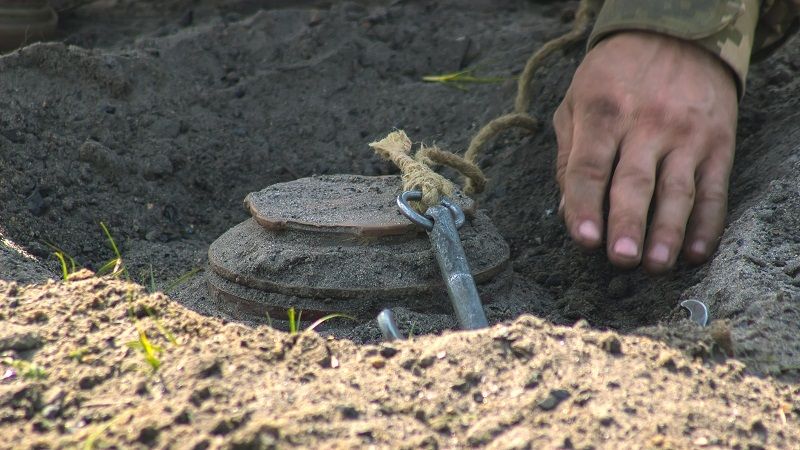A grassy lane rutted with tire tracks leads to Volodymyr Zaiets’ farm in southern Ukraine. He is careful, driving only within those shallow grooves — veering away might cost him his life in the field dotted with explosive mines.
Ukraine farmers surrounded by risks, from mines to logistics

“We have to do it,” he says, “Why be afraid?”
Across Ukraine, the war has forced grain growers into a vicious dilemma. Farmers in areas now free from Russian occupation must decide if it’s worth risking their lives to strip land of explosives before the critical spring planting season.
The dual crisis is causing many farmers to cut back on sowing crops. Bottlenecks in shipping grain by land and sea are creating losses, with expectations of a 20% to 30% reduction in grain output, poorer quality crops and potentially thousands of bankruptcies next year, according to industry insiders, Ukrainian government officials and international organizations.
The FAO says 90% of agricultural businesses lost revenue and 12% reported lands contaminated with mines. Land planted with grain dropped last year to 11.6 million hectares (28.6 million acres) from 16 million hectares (around 40 million acres) in 2021. That’s expected to fall to 10.2 million hectares (25.2 million acres) this year.
But growers can’t wait: April and May are key planting months for corn, the autumn months for wheat. Many are switching to planting oil seeds that are less costly.
“We have nearly 40 big farmers in our area, and nearly everyone is unable to access their lands except two,” said Hanna Shostak-Kuchmiak, head of the Vysokopillya administration that includes several villages in northern Kherson.
“Our heroes,” said Shostak-Kuchmiak, “who were driving their cars around picking up mines and bringing them to our deminers.”
Neither farmer felt they had the choice. Both knew that without a harvest this year, they will be insolvent by next.
Last month, one of his workers was killed and another was wounded while picking up metal missile remnants.
“If we sow, if we grow crops, people will have jobs, salaries and they will have a means to feed their families,” Shkuropat said. “But if we don’t do anything, we will have nothing.”
High costs of fuel, fertilizer and quality seeds only add to farmers’ woes. Most must sell their grain at a loss.
“No one is paying attention to the fact that already 40% less wheat has been seeded (this year), and we expect 50% less corn will be seeded in Ukraine,” he said, drawing on data from 3,000 farmers.
HarvEast CEO Dmytro Skornyakov said that his agricultural company pays almost $110 in logistics costs to export every ton of corn.
“It covers our expenses, but doesn’t give us any profit,” he said.
Negotiations are underway on renewing the U.N.-brokered agreement that allows Ukrainian grain to safely leave three Black Sea ports. Shippers say the deal isn’t working efficiently.
Transit routes through Europe are open even as Poland, Romania, Slovakia, Bulgaria and Hungary temporarily banned Ukrainian wheat, corn and some other products over concerns about their own farmers’ profits.
But those routes are slow and costly. Shipping by sea accounted for 75% of Ukrainian grain exports at the start of the year.
Meanwhile, some farmers won’t risk planting their fields.
Oleh Uskhalo’s land in Potiomkyne is awash with ammunition, the vast wheat farms reduced to a graveyard of scorched equipment.
“We can go on for another year,” he said. After that, he doesn’t know. He hopes for government compensation.
“I cannot send (my workers) to a field where I know mines and bombs are,” Uskhalo said. “To send a person to blow themselves up? I can’t do that.”
He faces resistance from his employees, eager to earn wages.
“The tractor drivers, they say, ‘We can go, we can sign a document stating that we take full responsibility,’” Uskhalo said.
It’s too risky, he told them.
In the distance, he can see a tractor equipped with disk tillers, a type of plow. “I wonder if it’s Volodymyr Mykolaiovych,” he said, referring to Zaiets.
“All it takes is for one of those disks to hit a mine and that’s it.”
In April, the farmer took a chance: He hopped on his tractor in his village of Borozenske, in Kherson, to head to a friend’s sunflower field to cut stalks.
He swerved to turn down a side farm road. He remembers the explosion, then waking up in a hospital bed with a collapsed lung and broken ribs.
Every day, he thinks of his 16 hectares (around 40 acres) of land, still unseeded.
“I will do it,” he said, straining to speak while a tube drains blood from his chest. “For a farmer, not planting means death.”
Read also
Wheat in Southern Brazil Impacted by Dry Weather and Frosts
Oilseed Industry. Leaders and Strategies in the Times of a Great Change
Black Sea & Danube Region: Oilseed and Vegoil Markets Within Ongoing Transfor...
Serbia. The drought will cause extremely high losses for farmers this year
2023/24 Safrinha Corn in Brazil 91% Harvested
Write to us
Our manager will contact you soon



